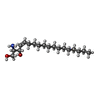+Search query
-Structure paper
| Title | Human Neonatal Fc Receptor Is the Cellular Uncoating Receptor for Enterovirus B. |
|---|---|
| Journal, issue, pages | Cell, Vol. 177, Issue 6, Page 1553-1565.e16, Year 2019 |
| Publish date | May 30, 2019 |
 Authors Authors | Xin Zhao / Guigen Zhang / Sheng Liu / Xiangpeng Chen / Ruchao Peng / Lianpan Dai / Xiao Qu / Shihua Li / Hao Song / Zhengrong Gao / Pengfei Yuan / Zhiheng Liu / Changyao Li / Zifang Shang / Yan Li / Meifan Zhang / Jianxun Qi / Han Wang / Ning Du / Yan Wu / Yuhai Bi / Shan Gao / Yi Shi / Jinghua Yan / Yong Zhang / Zhengde Xie / Wensheng Wei / George F Gao /  |
| PubMed Abstract | Enterovirus B (EV-B), a major proportion of the genus Enterovirus in the family Picornaviridae, is the causative agent of severe human infectious diseases. Although cellular receptors for ...Enterovirus B (EV-B), a major proportion of the genus Enterovirus in the family Picornaviridae, is the causative agent of severe human infectious diseases. Although cellular receptors for coxsackievirus B in EV-B have been identified, receptors mediating virus entry, especially the uncoating process of echovirus and other EV-B remain obscure. Here, we found that human neonatal Fc receptor (FcRn) is the uncoating receptor for major EV-B. FcRn binds to the virus particles in the "canyon" through its FCGRT subunit. By obtaining multiple cryo-electron microscopy structures at different stages of virus entry at atomic or near-atomic resolution, we deciphered the underlying mechanisms of enterovirus attachment and uncoating. These structures revealed that different from the attachment receptor CD55, binding of FcRn to the virions induces efficient release of "pocket factor" under acidic conditions and initiates the conformational changes in viral particle, providing a structural basis for understanding the mechanisms of enterovirus entry. |
 External links External links |  Cell / Cell /  PubMed:31104841 / PubMed:31104841 /  PubMed Central PubMed Central |
| Methods | EM (single particle) |
| Resolution | 2.9 - 3.8 Å |
| Structure data | EMDB-9684, PDB-6ilj: EMDB-9685, PDB-6ilk: EMDB-9686, PDB-6ill: EMDB-9687, PDB-6ilm: EMDB-9688, PDB-6iln: |
| Chemicals |  ChemComp-SPH:  ChemComp-K:  ChemComp-NA: |
| Source |
|
 Keywords Keywords | VIRUS / Echovirus 6 / CD55 / Cryo-EM / virus-receptor complex / FcRn |
 Movie
Movie Controller
Controller Structure viewers
Structure viewers About Yorodumi Papers
About Yorodumi Papers

















 echovirus e6
echovirus e6 homo sapiens (human)
homo sapiens (human)